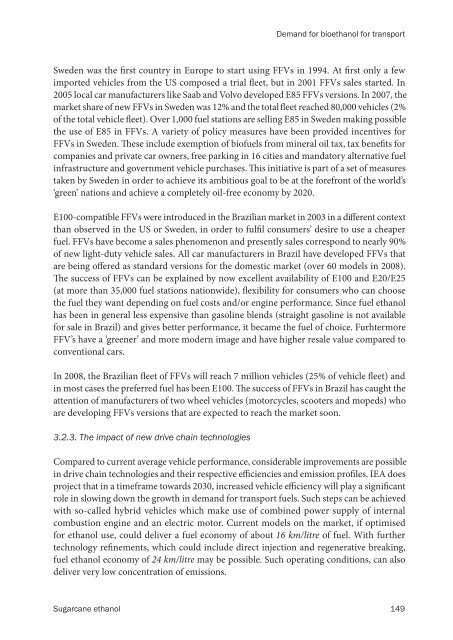Sugarcane ethanol: Contributions to climate change - BAFF
Sugarcane ethanol: Contributions to climate change - BAFF
Sugarcane ethanol: Contributions to climate change - BAFF
Create successful ePaper yourself
Turn your PDF publications into a flip-book with our unique Google optimized e-Paper software.
Demand for bio<strong>ethanol</strong> for transport<br />
Sweden was the �rst country in Europe <strong>to</strong> start using FFVs in 1994. At �rst only a few<br />
imported vehicles from the US composed a trial �eet, but in 2001 FFVs sales started. In<br />
2005 local car manufacturers like Saab and Volvo developed E85 FFVs versions. In 2007, the<br />
market share of new FFVs in Sweden was 12% and the <strong>to</strong>tal �eet reached 80,000 vehicles (2%<br />
of the <strong>to</strong>tal vehicle �eet). Over 1,000 fuel stations are selling E85 in Sweden making possible<br />
the use of E85 in FFVs. A variety of policy measures have been provided incentives for<br />
FFVs in Sweden. �ese include exemption of biofuels from mineral oil tax, tax bene�ts for<br />
companies and private car owners, free parking in 16 cities and manda<strong>to</strong>ry alternative fuel<br />
infrastructure and government vehicle purchases. �is initiative is part of a set of measures<br />
taken by Sweden in order <strong>to</strong> achieve its ambitious goal <strong>to</strong> be at the forefront of the world’s<br />
‘green’ nations and achieve a completely oil-free economy by 2020.<br />
E100-compatible FFVs were introduced in the Brazilian market in 2003 in a di�erent context<br />
than observed in the US or Sweden, in order <strong>to</strong> ful�l consumers’ desire <strong>to</strong> use a cheaper<br />
fuel. FFVs have become a sales phenomenon and presently sales correspond <strong>to</strong> nearly 90%<br />
of new light-duty vehicle sales. All car manufacturers in Brazil have developed FFVs that<br />
are being o�ered as standard versions for the domestic market (over 60 models in 2008).<br />
�e success of FFVs can be explained by now excellent availability of E100 and E20/E25<br />
(at more than 35,000 fuel stations nationwide), �exibility for consumers who can choose<br />
the fuel they want depending on fuel costs and/or engine performance. Since fuel <strong>ethanol</strong><br />
has been in general less expensive than gasoline blends (straight gasoline is not available<br />
for sale in Brazil) and gives better performance, it became the fuel of choice. Furhtermore<br />
FFV’s have a ‘greener’ and more modern image and have higher resale value compared <strong>to</strong><br />
conventional cars.<br />
In 2008, the Brazilian �eet of FFVs will reach 7 million vehicles (25% of vehicle �eet) and<br />
in most cases the preferred fuel has been E100. �e success of FFVs in Brazil has caught the<br />
attention of manufacturers of two wheel vehicles (mo<strong>to</strong>rcycles, scooters and mopeds) who<br />
are developing FFVs versions that are expected <strong>to</strong> reach the market soon.<br />
3.2.3. The impact of new drive chain technologies<br />
Compared <strong>to</strong> current average vehicle performance, considerable improvements are possible<br />
in drive chain technologies and their respective e�ciencies and emission pro�les. IEA does<br />
project that in a timeframe <strong>to</strong>wards 2030, increased vehicle e�ciency will play a signi�cant<br />
role in slowing down the growth in demand for transport fuels. Such steps can be achieved<br />
with so-called hybrid vehicles which make use of combined power supply of internal<br />
combustion engine and an electric mo<strong>to</strong>r. Current models on the market, if optimised<br />
for <strong>ethanol</strong> use, could deliver a fuel economy of about 16 km/litre of fuel. With further<br />
technology re�nements, which could include direct injection and regenerative breaking,<br />
fuel <strong>ethanol</strong> economy of 24 km/litre may be possible. Such operating conditions, can also<br />
deliver very low concentration of emissions.<br />
<strong>Sugarcane</strong> <strong>ethanol</strong> 149












